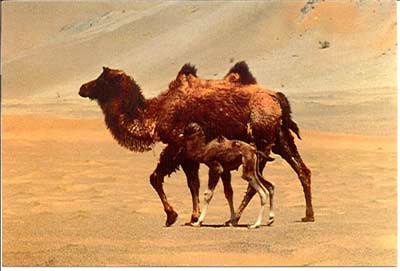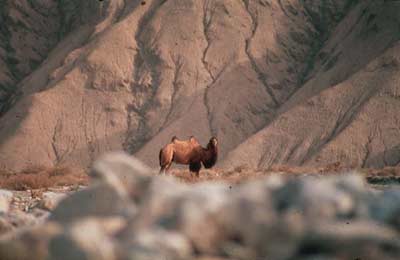"Women often ask if they can tag along on my expeditions but I usually have a good excuse to put them off," John Hare said, eyes twinkling, "In this case, because we were again traipsing across the Lop Nur Desert, a former Chinese nuclear test area, I simply explained: 'Well, dear, a pretty young thing like you might not want to suffer the amazingly ill effects of radiation but for an old chap like me who's bound to die soon…after hearing that, the ladies aren't so eager to go with me.'" But clearly Mr. Hare, a surprisingly fit and handsome English gentleman somewhat over sixty, could charm the pants off of any woman of any age. He's dapper, humorous and has the extremely endearing quality of never taking himself too seriously.

One evening in early May he presented an update on his camel preservation work for the Wild Camel Protection Foundation inside the Beijing Bookworm. The Bookworm's owner, Alex Pearson, introduced Mr. Hare as a long time Fellow of the Royal Geographical Society and the Explorers' Club of America and as a man not new to danger in the deserts of Africa and Asia. In 2004 the Royal Geographical Society gave him the Ness Award for raising awareness about wild Bactrian camels and he was also awarded the Lawrence of Arabia Memorial Medal for exploration under extreme hazard by the Royal Society of Asian Affairs. In October 2006 he received the Mungo Park medal for distinguished contributions to exploration by the Royal Scottish Geographical Society. In 2006 Mr. Hare trekked around Lake Turkana in Kenya on camels and also he's ridden camelback through the African Sahara. In China in 1999 Mr. Hare made a camel expedition through the dangerous dunes and deserts near Tibet. His group rode into two virgin valleys, where they encountered undomesticated Argali sheep, black tailed gazelle and wild camels that had never seen humans before. After this trip the intrepid explorer established The Lop Nur Wild Camel National Nature Reserve to protect the wild Bactrian camel. Later, in November 2005 he returned to the same area via a different route. This time he found that a rare fresh water spring he'd discovered during his last trip had been poisoned. Illegal miners seeking to mine gold from the region had contaminated the water with over eighty large drums of potassium cyanide. But Mr. Hare's most recent trek into the Lop Nur confirmed the fact that the Xinjiang government, along with the state environmental protection agency (SEPA), had indeed made great efforts to clean up the contaminated spring. "It's impossible to police the area, it's too vast and desolate, but the Chinese have done a remarkably good job at clearing up the mess I discovered in 2005," he said, adding that his group had also discovered other things as well. "While trekking in via a new route around the ancient abandoned city of Lou Lan (AD 400), we found a remarkable piece of cloth along with various other artifacts: jade, coins, arrowheads and bits of felt."

"The weave of this fabric is now being carefully evaluated by experts in Europe and America. It appears to match the weave of ancient Celts," Mr. Hare said, "This might be a clue to the remarkable non-Asiatic mummies dating back to 1400 BC that have been discovered around Xinjiang in the last century. It seems that these people came in waves from Persia." Exploring the desert has hazards: Mr. Hare severely burned his feet walking through sand dunes, and he bashfully admitted that his age had made him more vulnerable during the expedition. The air was so dry that his fingers cracked open and bled; voracious ticks attacked the group at water holes. Wolf cubs were even smoked out while burning an area to make a water source available for their camels. Mr. Hare casually remarked that wolves are natural predators of camels. "The desert is harsh but starkly beautiful," he continued, smiling, "Colors are marvelous and constantly changing on the sands and rocks as night falls. It's not crowded like other parts of China; I was 200 miles from the nearest human yet at times I did have to shout over my mount to speak to my comrades because the winds were so fierce in certain parts of the desert. We rode on domestic camels because they're more reliable than jeeps or trucks and because the wild camels are normally very timid and would run off at the sound of a vehicle. They were actually attracted to our camels so I fortunately got to observe some wild ones at remarkably close range." Bactrian camels are remarkable creatures. "They are the only mammals that can survive on the salt water that bubbles out of the Lop Nur desert," Mr. Hare said. "They're smart too; they seemed to sense that the fresh water spring we re-visited was poisoned; the beasts trembled and shook, and refused to get near the water." During his talk he also suggested that the wild Bactrian camel might be a separate species from the domestic Bactrian: their double humps and head shapes are distinctly different and the DNA samples he took have shown a marked disparity. "You know humans differ from chimps by 5% disparity in their DNA; the two species of camels have a 3% difference; that's very impressive," the explorer remarked. According to Mr. Hare only 600 wild Bactrian camels exist in the wild on the reserve he has established in China; 450 inhabit another national reserve in Outer Mongolia. "The two groups used to be one," he explained, "When people built railway lines in the 1920's they created an effective boundary: camels travel in single file; they simply will not cross a path made by a machine. They're very shy. And any kind of rut or path will cause them to turn away. That Outer Mongolian reserve, by the way, was originally set up to help reintroduce the Pierzynski Wild Horse into nature. Some friendly nomads caught twelve wild camels for us and now I'm happy to tell you that natural breeding efforts have increased the population to twenty one currently." John Hare will undoubtedly continue his adventures. "The wild camel is a migratory species that travels from one water point to another," he explained, "and their life in the Lop Nur Desert, with radioactive testing, doesn't seem to have affected their immune systems or DNA a bit; they're doing jolly well, as far as I can tell." Mr. Hare, like his beloved creatures, also continues to thrive and migrate as well, slogging across harsh deserts and flying around the developed world in an optimistic, ambitious effort to preserve his rare wild camels living in their harsh and far-flung homeland.
(China.org.cn by Valerie Sartor, May 22, 2008)